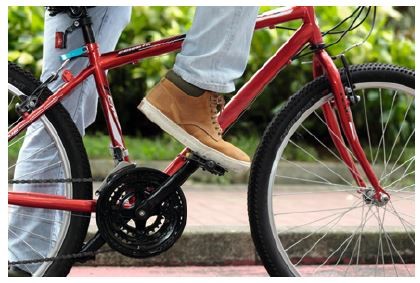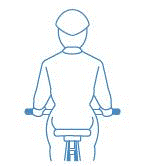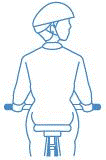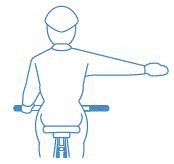Basic cycling skills
As a new rider, learn and practise the following basic skills at a suitable and safe place away from any traffic and where you can do so safely without causing any inconvenience or risk to others.Do not ride on the road until you can ride your cycle with good balancing and steering, starting and stopping --- well enough for you to concentrate on and cope with the dangers of the road and other traffic.
Do not ride on the road until you can ride your cycle with good balancing and steering, starting and stopping - well enough for you to concentrate on and cope with the dangers of the road and other traffic.
Moving off - practise this skill following a narrow path as you become more competent. Use a low gear, if fitted.
Slowing down and stopping - practise progressive and controlled braking, bringing your cycle to a stop smoothly and in the exact place required. Try it at speed. On a wet surface, it will be more difficult.
 Pedalling, balancing and steering - use the balls of your feet to pedal. A smooth pedalling style that exerts force throughout the entire circle will help balancing the cycle. Even at low speeds, do not freewheel but keep pedalling. Try and practise steering around markers or other obstacles.
Pedalling, balancing and steering - use the balls of your feet to pedal. A smooth pedalling style that exerts force throughout the entire circle will help balancing the cycle. Even at low speeds, do not freewheel but keep pedalling. Try and practise steering around markers or other obstacles.
Emergency braking - apply both front and rear brakes simultaneously. Try and practise emergency braking by stopping as quickly as you can (also see ʻBrakingʼ on right).
When you have mastered these skills, try them again and also practise looking behind and giving correct signals. Develop a constant awareness of all other vehicles and pedestrians around you, including their positions and speeds. You can find advice on what to do and when to do it in this chapter.
Braking
Learn which hand works the front brake and which hand works the rear brake. Apply the rear brake for smooth gradual slowing down. The front brake is more powerful and efficient. However, if you apply it too hard, the cycle will stop more abruptly and the rear wheel may lift off the ground causing you to lose control or even fly over the handlebars, particularly when going downhill at speed. In normal riding conditions, apply the rear brake first, then the front brake. Control your speed by braking appropriately when travelling downhill or before rounding a bend. Only brake when the front wheel is straight.
A system for safe cycling
Before moving off, stopping, or turning, always carry out the following routine:
 |
- Think -- Think carefully what you want to do and allow sufficient time to do it.
|
 |
- Look -- Check if it is safe to manoeuvre; look ahead, behind and all around.
|
 |
- Signal -- Signal what you intend to do, provided it is safe. Arm signals must be correct, clear and given in good time.
|
It is only when the above steps have been taken that it is safe to move off, stop, or change speed or direction.
Safe Cycling
 Pedalling, balancing and steering - use the balls of your feet to pedal. A smooth pedalling style that exerts force throughout the entire circle will help balancing the cycle. Even at low speeds, do not freewheel but keep pedalling. Try and practise steering around markers or other obstacles.
Pedalling, balancing and steering - use the balls of your feet to pedal. A smooth pedalling style that exerts force throughout the entire circle will help balancing the cycle. Even at low speeds, do not freewheel but keep pedalling. Try and practise steering around markers or other obstacles.

